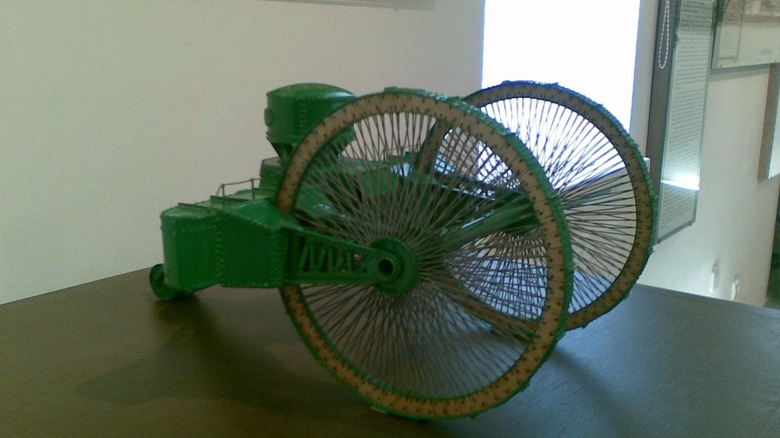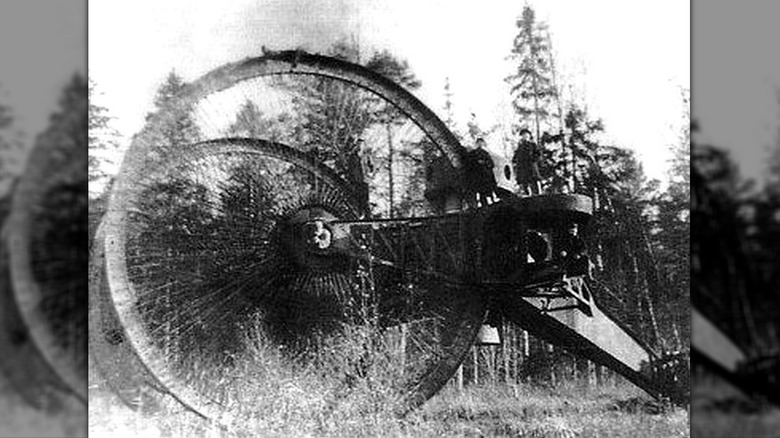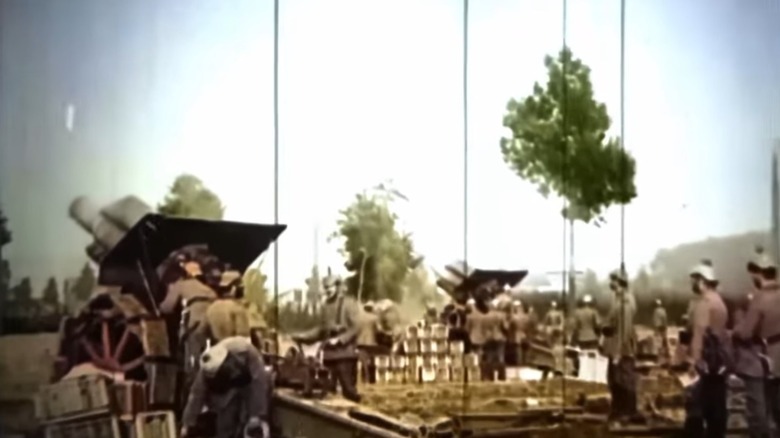Why Did The Russian Tsar Tank Fail?
When picturing a tank, most people would include tracks, a relatively low profile, and a design that likely looks nothing like the strange Tsar Tank. First tested in 1915, the Tsar Tank was an ultimately unsuccessful attempt at revolutionizing the battlefield. Developed by Russian engineers Nikolai Lebedenko, Alexander Mikulin, Nikolay Yegorovich Zhukovsky, and Boris Stechkin, the Tsar Tank was meant to send enemies running in fear during WWI. Unfortunately, the tank proved to be problematic and was eventually scrapped.
The Tsar Tank was outfitted with two massive front wheels on either side, and a much smaller third wheel centered in the rear. Looking more like a giant piece of farming machinery, this tank was nearly 30 feet tall, and included several weapons. The Tsar Tank came with a center turret equipped with either machine guns or small cannons, and had more cannons or machine gun slots on the sides, just past the rear of the front wheels. However, there were a few significant issues that held the Tsar Tank back and ultimately prevented it from graduating past a prototype.
First, it was prone to getting stuck in uneven terrain, which would seriously hamper any forward push toward the enemy. Secondly, Russian tank operators on the Tsar Tank would have been taking a massive risk heading into combat, as it was believed to be overly susceptible to enemy artillery. The Russians weren't the only country tinkering with odd combat vehicles during WWI, though: The German Sturmpanzerwagen A7V makes the list of the weirdest tanks in history.
Poor weight distribution caused maneuverability issues
A successful tank needs to posses the ability to overcome physical obstacles and navigate rugged terrain to be effective. The designers behind the Tsar Tank thought of this and attempted to make a vehicle that wouldn't get bogged down traversing the environment. The two sizeable front wheels were meant to help the tank easily roll over uneven ground, but it had a fatal flaw.
While the two gigantic wheels up front could roll over nearly anything, the hull, turret, cannons, and engine were positioned behind them, resulting in significant amounts of weight resting on the small singular rear wheel. On a flat plain with little elevation, this small rear wheel performed as intended and functioned as the steering for the Tsar Tank. But when real-world situations presented themselves, such as mud, ruts, or inclines, the wheel often became stuck. This unfortunate situation had little to do with engine power, as the prototype of the Tsar Tank benefited from repurposed and robust powerplants from seized German airships. Fortunately, tanks continued to develop, and the major differences between WW1 and WW2 tanks show the advancements achieved.
One gigantic target
A good tank design requires balancing many elements, including firepower, speed, and armor, among several other considerations. While the Tsar Tank included capable weaponry and could move up to 10 mph, its crew of 10 men weren't well-protected from enemy artillery. While the Tsar Tank was made from thick metal, Russian military leadership wasn't confident it would stand up to artillery like the destructive German howitzer. This was a major threat — upwards of 60% of combat deaths during World War I were a result of explosive artillery, per TheWorldWar.org.
One particular 420mm German howitzer, nicknamed "The Big Bertha," reportedly left a crater 28 feet across and 6 feet deep in the ground. Considering the damage such a blow would cause, imagine the Tsar Tank and its massive profile lumbering across the battlefield. The herculean wheels and incredibly tall turret would make for an easy target, especially if that rear wheel was continually getting stuck. While the Tsar Tank was certainly a bizarre idea, it was only one of the strange tank prototypes that never made it to battle.


